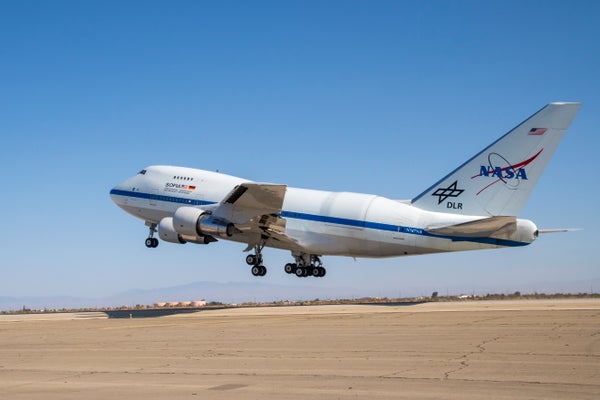NASA and the German Aerospace Center are permanently shutting down the Stratospheric Observatory for Infrared Astronomy (SOFIA), a telescope on an aeroplane that has been scrutinized for years for its high cost and low scientific output. Since 2014, the observatory has made hundreds of flights above the water vapour in Earth’s atmosphere to get an unobscured view of celestial objects and to gather data at infrared wavelengths.
SOFIA has measured magnetic fields in galaxies, spotted water on sunlit portions of the Moon and detected the first type of ion that formed in the Universe, helium hydride. But it costs NASA around US$85 million a year to operate, which is nearly as much as the operational expenses for the Hubble Space Telescope. On 28 April, NASA and the German Aerospace Center, the two partners in SOFIA, announced that they will close down the observatory by 30 September.
The observatory’s high price tag, combined with its relatively low scientific output until recently, earnt it a low ranking in last year’s decadal survey of the future of US astronomy and astrophysics. NASA cited the survey’s recommendation to shutter SOFIA — put forward by the astronomy community — when it announced its decision. The observatory was originally meant to have a 20-year lifetime, but it will now be decommissioned after only 8 years.
On supporting science journalism
If you're enjoying this article, consider supporting our award-winning journalism by subscribing. By purchasing a subscription you are helping to ensure the future of impactful stories about the discoveries and ideas shaping our world today.
“It’s a very difficult decision, and certainly very painful for everyone who has worked on the mission,” says John O’Meara, chief scientist at the W. M. Keck Observatory in Kamuela, Hawaii, who has worked on long-term plans for astronomy and astrophysics in the United States. But “it’s the right call”.
SOFIA costs more to run each year than many of NASA’s other astrophysics missions combined. The German Aerospace Center contributes 20% of operating costs. The observatory is expensive because, unlike space telescopes, it requires pilots and a staff to fly and fuel it.
‘Globally unique’
SOFIA is a Boeing 747 with a hole cut in its side to accommodate a 2.5-metre-wide, 17-tonne telescope, which peers out at the Universe as the plane flies at altitudes between about 11 and 14 kilometres. It has made approximately 800 scientific flights since it became operational in 2014. The plane flies mainly from its home base in Palmdale, California, although it has also been deployed in locations including Germany, Chile and New Zealand — the latter two to observe celestial objects that are visible only from the Southern Hemisphere.
SOFIA collects data that are not gathered by either ground-based observatories or space-based infrared telescopes, such as the James Webb Space Telescope, which was launched last year. It is the only observatory that can currently make observations at some far-infrared wavelengths. “SOFIA is globally unique,” said Walther Pelzer, head of the German space agency, in a statement announcing its closure.
Its infrared capabilities allow SOFIA to make other unique observations, such as those that led to the detection of water on the sunlit Moon. “The shutdown is unfortunate for lunar science and exploration, as we have just begun mapping water on the Moon with SOFIA,” says Paul Lucey, a planetary scientist at the University of Hawaii at Manoa in Honolulu. “SOFIA’s capability is unique — there are no other observatories or spacecraft able to map the water molecule on the illuminated Moon.”
Under scrutiny
SOFIA’s scientific output has long been questioned. In 2019, a pair of NASA-commissioned reviews highlighted that the observatory had not resulted in large numbers of highly cited publications. In the first 6 years after operations began, it produced 178 scientific papers, compared with more than 900 from Hubble’s first 6 years.
In response to the reviews, SOFIA brought in a new director, Margaret Meixner, and ramped up its focus on scientific productivity. “SOFIA has been transformed over the last three years,” Meixner says, doubling its annual publication rate over that period. She says that its scientific output is comparable to the European Space Agency’s Herschel Space Observatory, which was the most recent space telescope that operated at far-infrared wavelengths, and that SOFIA’s science addresses many of the priorities for future research that are laid out in the decadal survey.
Asked whether NASA had taken recent SOFIA discoveries into account when making its decision, agency spokesperson Alise Fisher pointed to the decadal survey, which states that it “found no evidence that SOFIA could, in fact, transition to a significantly more productive future”.
Charles Woodward, an astronomer at the University of Minnesota in Minneapolis, says that SOFIA’s closure has led to a feeling of “melancholy” among infrared astronomers, given that its productivity had been rising. “A significant portion of the community will think that SOFIA got the short end of the stick,” he says.
In recent years, several budget requests from US presidents have recommended terminating SOFIA. In each case, Congress — usually led by House of Representatives minority leader Kevin McCarthy, who represents a district near Palmdale — provided funds to keep it going. The latest decision might render congressional wishes moot.
Between now and 30 September, SOFIA is scheduled to make its final observations, possibly including a deployment to New Zealand. NASA and the German space agency will then decommission the aeroplane.
This article is reproduced with permission and was first published on April 28 2022.
